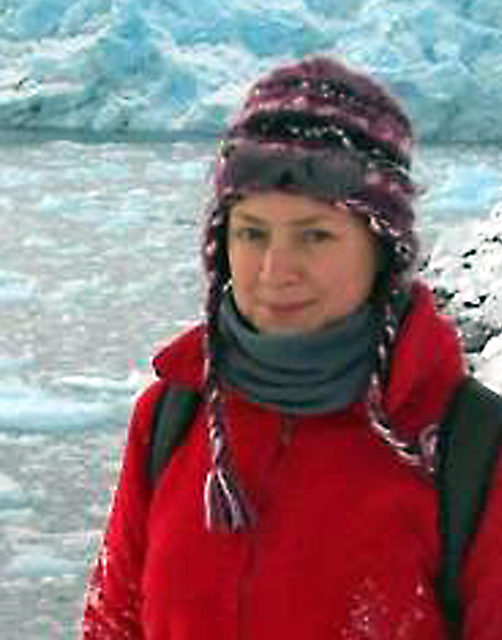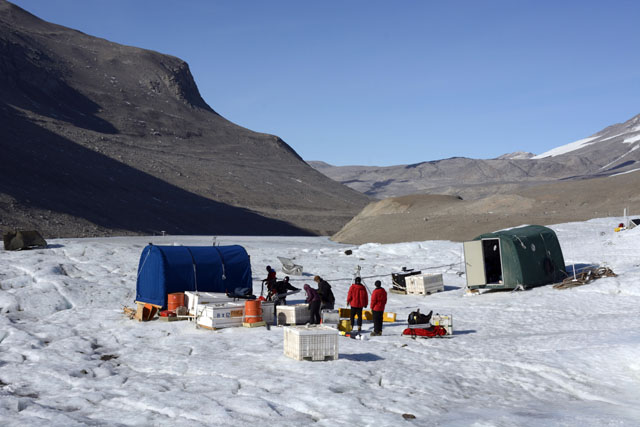Lifeblood of a glacierProbe melts its way into river of ice to retrieve brine that feeds red-stained featurePosted March 4, 2015
The name alone evokes a certain mystery on a continent riddled with enigmas. 
Jill Mikucki
Blood Falls, however, is slowly giving up its secrets. A team of scientists and engineers sent a probe into the cold ice of Taylor Glacier during the 2014-15 field season. In the first feat of its kind, they extracted super salty samples of water from the main vein that feeds the red-stained feature at the glacier’s snout. “It was one of those exciting moments in research,” Jill Mikucki said after returning to McMurdo Station following three weeks working atop the slick, crevassed river of ice. “The thing that I love about Antarctic work is that it is both physically and mentally challenging. You have to pull all of your energy together to achieve these successful moments together as a team.” Holding up a small, sealed vial of liquid that had been flowing through a channel in the ice nearly 20 meters below the surface, Mikucki talked excitedly about all the work still ahead. There are tests to investigate the chemistry of the water to learn more about its history and origins. Then there are the microbes found in the hypersaline water itself: What kind of organisms can survive in such an extreme environment? “This is going to be an exciting sample to play with,” said Mikucki, an assistant professor of microbiology at the University of Tennessee whose research is funded by the Antarctic Integrated System Science Program with the National Science Foundation’s Division of Polar Programs, which manages the U.S. Antarctic Program. A decade ago, she first collected brine as it flowed from below the glacier into the surface of ice-covered Lake Bonney, located at the extreme western edge of Taylor Valley in the McMurdo Dry Valleys, which is the largest relatively ice-free area in Antarctica. Subsequent analyses of the 2004 samples, published in the journal Science in 2009, found that a community of microorganisms exists in a liquid reservoir several times saltier than seawater somewhere below the glacier. The vibrantly colored Blood Falls feature itself results from the discharge of that iron-rich, saline liquid. Its very chemistry is altered by the bacteria, which likely manipulate sulfur and iron compounds to survive in the light-starved environment. The liquid oxidizes at the surface, giving the ice its distinctive bloodstained coloration. However, episodic discharges at the surfaces are unpredictable. Samples from the surface may be altered once they reach open air. Any further investigations of Blood Falls and the subglacial plumbing would require a different approach. That was the impetus for the MIDGE (Minimally Invasive Direct Glacial Exploration) project, led by Mikucki as the principal investigator and involving a diverse team of microbiologists, geophysicists and glaciologists. [See previous article — The next step: U.S. scientists, German engineers prepare to explore below Blood Falls in 2014-15.] Her team also included a group of German engineers and scientists who had been developing a special probe with an eye toward exploring icy moons in the solar system for a project called Enceladus Explorer (EnEx). 
Photo Credit: Peter Rejcek
Taylor Glacier terminates at the western lobe of ice-covered Lake Bonney. Blood Falls can be seen at the far right side of the lake.
The DLR German Space Administration is providing funds to a research consortium of six German universities to build the probe, dubbed EnEx-IceMole. Bernd Dachwald, professor of astronautical engineering at FH Aachen University of Applied Sciences, is the lead investigator for the German team. “I am very happy that the cooperation with our American partners worked so well and that we managed to achieve both our engineering and scientific goals,” Dachwald said. “For the EnEx team, this was an important first step towards future applications of this technology in space and hopefully in Antarctica again.” The IceMole is a long rectangular metal box with a copper head and ice screw at one end capable of melting its way through ice – but not just straight down like a conventional electro-thermal drill. Differential heating at the tip allows IceMole to change directions. It looks a bit like a very large hypodermic needle poised to inoculate a glacier. “It can drive curved trajectories through bulk ice. It can go sideways, up and down. If you want to reach any point, you can go there,” explained Dirk Heinen, a German physicist, while troubleshooting the first attempt to send the IceMole into Taylor Glacier that ended shortly after it began. |



For USAP Participants |
For The Public |
For Researchers and EducatorsContact UsU.S. National Science FoundationOffice of Polar Programs Geosciences Directorate 2415 Eisenhower Avenue, Suite W7100 Alexandria, VA 22314 Sign up for the NSF Office of Polar Programs newsletter and events. Feedback Form |




